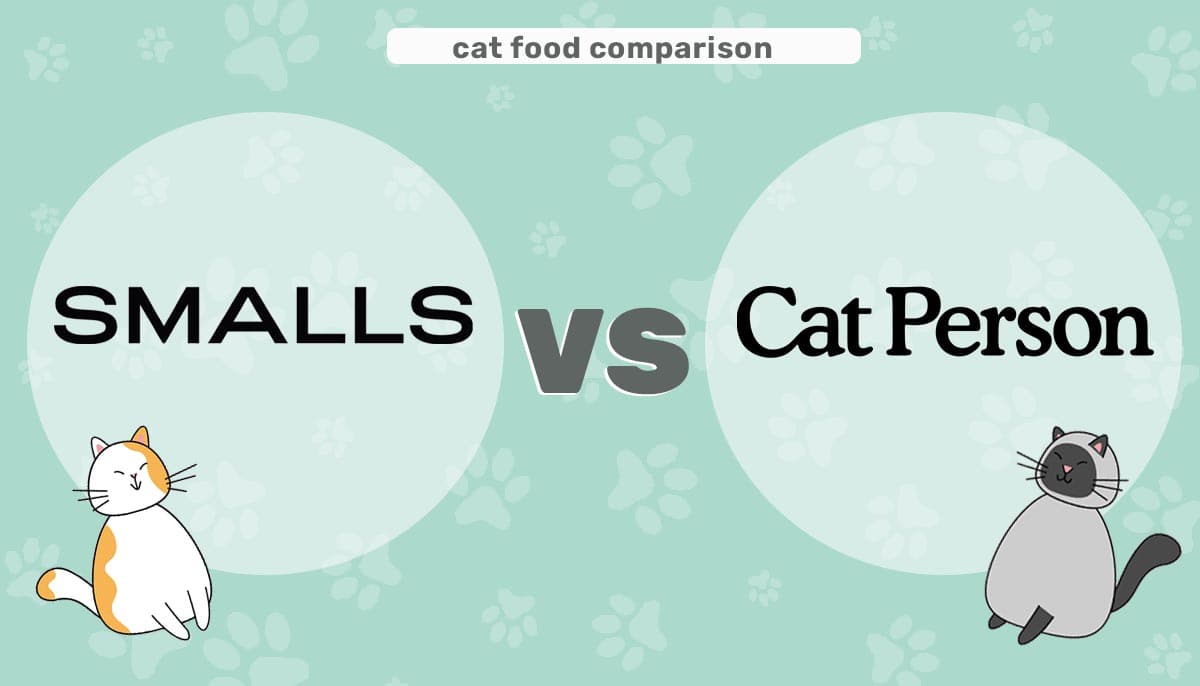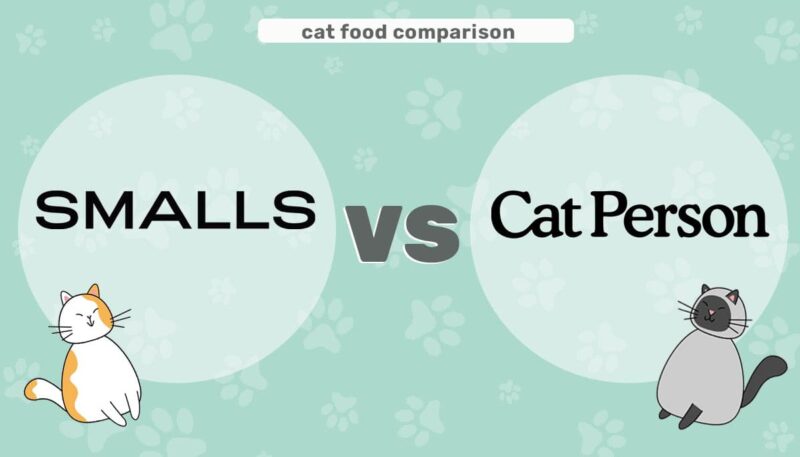Click to Skip Ahead
Fresh dog foods have long been all the rage in the canine world, but it hasn’t been until recently that the same could be said for cat foods.
A fresh food diet is ideal for cats as they’re high in protein, a necessary macronutrient for your favorite lil’ carnivore. But finding a high-quality fresh cat food manufacturer can feel overwhelming. That’s where Smalls and Cat Person come in.
Both companies manufacture fresh cat food and operate on a subscription model. While both are committed to producing healthy cat foods that arrive at your doorstep every month, they’re two completely different companies with very different product lines and price points.
Smalls focuses primarily on their USDA-certified, gently cooked wet food recipes. Cat Person has an extensive line of wet foods, but they also manufacture a quality line of treats and dry food.
If you’re on the fence about which company to support, we can help. Keep reading to find out all you need to know about both manufacturers so you can make an informed buying decision.
A Quick Comparison
| Image | Product | Details | ||
|---|---|---|---|---|

|
Smalls Human-Grade Fresh Cat Food |
|
Click to Save 40% Use code: Catster24 | |

|
Cat Person Fresh Cat Food |
|
CHECK PRICE | |
Brands at a Glance
| Brand name | Smalls | Cat Person |
| Established | 2016 | 2020 |
| Headquarters | New York | New York |
| Product lines | 3 | 3 |
| Parent company/major subsidiaries | N/A | Harry’s Labs |
Brief History of Smalls

In 2016, two cat-loving friends teamed up to create Smalls after realizing a gap in the cat food market needed filling. At the time, countless startups focused on healthy dog food recipes, but the same couldn’t be said for cat food. Founders Matt Michaelson and Calvin Bohn decided to challenge this gap and began home-cooking cat food in small batches in their New York City apartments for their friends. As their company grew, the pair found themselves delivering the cat food all over NYC in a ZipCar, eventually realizing they needed to expand to larger kitchens and call on professional chefs to continue growing the business.
Brief History of Cat Person

The co-founders of Cat Person, Lambert Wang and Jimmy Wu, created their company after realizing that most pet stores heavily concentrated on dog products. They didn’t like that big box stores seemed to have only an aisle or two dedicated to cat products while the rest was heavily focused on dogs’ needs. So, in creating Cat Person, they set out to change how cat owners felt when shopping for goodies for their pets.
Cat Person launched in 2020 with an initial product line focusing on high-protein cat food and products such as a cat bed, cat bowl, and catnip toys.
Smalls Manufacturing
The company’s headquarters are in New York, but its wet food recipes are made in New Jersey.
The company’s fresh ingredients are sourced from reliable United States or Canadian suppliers. Even their supplement mix is made in America.
Each batch of Smalls is individually tested for pathogens and must pass strict standards on a nutritional and micro level before being approved for shipping. Their food is crafted by animal nutritionists and cooked in USDA-inspected human food processing facilities.
Smalls leans much of the buzz term “human grade” in its marketing. This term has no legal definition, and it doesn’t hold much weight. In the case of Smalls, their food being “human grade” essentially just means that the recipes are created in human food facilities with ingredients that are fit for human consumption.
Cat Person Manufacturing
Like Smalls, Cat Person’s food is made in different places.
Their wet food line is made in Thailand. The company chose a manufacturer that supplies primarily human food. Though the company is not explicitly stated in Cat Person’s frequently asked questions, they state that this manufacturer focuses on sustainable ingredient sourcing and legal labor. The high focus on traceability means that this manufacturer can ensure its suppliers’ operations and labor conditions are responsible and sustainable.
The dry food line is manufactured in the United States by a food ingredient provider with high standards for pet food manufacturing. The dehydrated protein sources in these blends are ethically and responsibly sourced. The facility also uses solar-powered energy for further sustainability.
Finally, their Goodness Blends—the company’s treat line-up—are also made in the U.S.

Smalls Product Line

Smalls is known for its high-protein and preservative-free fresh food line-up, but they also have treats.
Fresh Ground/Smooth Food
The company’s biggest seller is their line-up of fresh ground or smooth recipes. These recipes include four protein options: fish, bird, “other bird,” and cow. The difference between their “ground” and “smooth” recipes is the texture, allowing cat parents to pick the type of food they know their cat would prefer. The “smooth” line resembles pates, while the “ground” recipes are minced, providing a meatloaf-like texture.
Recipes in this line-up are gently cooked to lock in nutrients and made with ingredients fit for human consumption. There are no fillers or preservatives.
Pantry Items
Smalls subscribers can also access the company’s “pantry items,” including snacks like giblets and broth. They also manufacture catnip toys and silica cat litter.
Cat Person Product Line

Wet Food
Cat Person has a huge wet food product line, especially when compared to Smalls. They have two texture options: shreds in broth or pate. In addition, eight protein options are available in both textures: chicken, tuna, mackerel and bream, salmon and tuna, turkey and chicken, duck and chicken, duck, and beef.
Their wet food comes in packs of five 2.75-ounce cups.
Dry Food
Cat Person’s dry food line consists of just three flavors: salmon and tuna, duck and turkey, or chicken and turkey. Each recipe is available in a two-pound bag.
Their dry food provides 75% more protein than the industry standard.
Treats
Cat Person’s treat line-up, known as its Goodness Blends, consists of five recipes. Each recipe is designed to provide targeted support for your cat’s individual needs. For example, their Immune Support treats are made with antioxidants like vitamins C and E. The Skin & Coat blend is made with fatty acids and zinc to support healthier skin and better fur growth.
Head-to-Head Comparison
Price
Price can be a big determining factor for people looking to find their cats the best food possible. There’s no point in trying Smalls or Cat Person if you can’t afford to continue buying their food once your trial period ends. Thankfully, both companies are pretty straightforward with the costs associated with their subscription services.
Smalls
Smalls provides prospective customers with the option to purchase a sampler box. The price of this box can vary depending on what deals and discounts the company offers. At the time of writing, the sampler is available for $32.00. This box contains ten of their fresh cat food recipes in both available textures and a free bag of catnip treats.
Once consumers have had a chance to test out all the flavors and know which their pet prefers, they can choose what recipes they’d like to receive in their subscription box.
Smalls’ fresh food plans begin at $4 per day per cat or $0.80 per ounce. Four dollars is the cost of one of their fresh food recipes. If you’re feeding your kitty one package per day, you should then expect to pay $120 monthly at the minimum for the fresh food plan. The company has a page on its website recommending how much of its fresh food you should feed your cat based on its weight. It suggests that the average 10-pound cat eats one packet per day.
As for their treats, Smalls giblets are $10 per bag, while their bird broth is $5.
The cost of shipping will depend on the size of your order. Consumers may be charged a $10 shipping fee.
Cat Person
As with Smalls, prospective customers can try a starter box to gauge their cat’s interest in Cat Person’s food. They have two starter box options, one containing wet and dry food samples and one with only wet food. Their wet and dryer starter box contains one two-pound bag of dry food and two packs of wet food for $33.50. Their wet-only starter kit contains four packs of wet food for $38.00. You can edit your starter box to have the flavors you think your cat would like best. The starter box contains enough food to feed one cat for around two weeks.
After the trial box, Cat Person’s wet food recipes cost $9.50 per pack of five 2.75-ounce cups, or $0.69 per ounce.
Their dry food costs $14.50 per two-pound bag.
The company’s treats cost $19.50 for a box of 14 pouches. Each pouch contains 1.4 ounces of 40 grams of treats.
Cat Person provides free shipping on orders over $45.
Warranty
Anyone with a cat can tell you how picky they can be, especially regarding food. Trying a new cat food brand can feel risky when you have a picky kitty, so it’s good to know the return policies of the companies in question before you place an order.
Smalls
Smalls offers a full refund of the trial order if the prospective customer’s cat doesn’t approve of the food. Refund requests are only honored after the initial two-week trial period has been completed and must be made before 30 days of the initial date of purchase.
Cat Person
Cat Person has a 30-day 100% satisfaction guarantee on all first orders.
Customer Service
Customer service is always essential when buying anything online, especially when you’re spending so much money. Unfortunately, neither Smalls nor Cat Person are necessarily budget-friendly cat foods, so knowing you can contact customer service if you run into any issue with your order is essential.
Smalls
There are two ways to contact customer service at Smalls, via email or text message. The company’s “Cat Concierge” team is available between 10 AM and 7 PM EST Monday through Thursday, 10 AM to 6 PM EST on Fridays, and 1 PM and 6 PM EST on Saturdays and Sundays.
Current Smalls subscribers say it can be difficult to reach customer service as there is no call line to talk to a real person via the phone.
Cat Person
As with Smalls, Cat Person can be contacted via text or email. Unfortunately, they do not list hours of operation on the website.
Like Smalls, current subscribers report that getting a hold of customer service can be challenging.
Wet Food
The biggest sellers for both Smalls and Cat Person are their wet food recipes.
Smalls has two texture options: ground or smooth. Each is available in four flavors. Their recipes are crafted specifically to lock in the nutrients of the fresh, high-quality ingredients. No fillers or preservatives are added, and each recipe is frozen after cooking to maximize freshness. Smalls’ recipes are developed in partnership with veterinary nutritionists and are designed to meet the AAFCO standards for cats of all life stages.
The company sources its ingredients from reliable U.S. and Canadian suppliers using foods edible by humans. The wet food can be kept in a sealed container in the fridge for up to a week, but frozen, it can last up to a year.
Cat Person has two texture options: shreds in broth or pate. Each texture is available in eight flavors. The company packs its recipes with more animal protein than recommended by the AAFCO standards. However, we could not find any in-depth information regarding how this company’s recipes are crafted. In addition, some of its recipes use ingredients sourced from non-North American vendors.
Cat Person’s recipes have best-before dates on the packaging, and any opened wet food should be refrigerated and used within two days.
- Smalls
Dry Food
Smalls doesn’t have a kibble option.
Cat Person’s dry food, like its wet food, is higher in protein than the industry standard. It’s low in carbohydrates and grain-free. Each recipe is made with two all-natural proteins, so it’s easy for consumers to avoid any allergy-inducing ingredients.
We could not find any details about how Cat Person’s dry food is crafted. Still, we appreciate that each recipe has its own website with information about the ingredients and why they were chosen.
- Cat Person
Treats
When it comes to treats, Smalls has just two options: niblets or broth.
Their niblets are single-protein, bite-sized giblets made with just one ingredient. They come in chicken flavor only. The broth is essentially a chicken broth made for cats. It’s designed to be splashed onto meals or served on the side as a special treat. We could not find websites for each treat type with more detailed information.
Cat Person has five treat options designed to address specific issues your cat may face. For example, their Cognitive Health blend is ideal for cats needing additional brain health and development support. The Digestive Support treats contain ingredients designed to support a healthy gut and intestinal bacteria.
Each option has its own detailed website containing an in-depth description of the treat and its ingredients.
- Cat Person
Overall Brand Reputation
Variety
- Cat Person
Cat Person has a much larger line-up of food options, especially when considering their wet food line and their treats. In addition, they have many more protein sources than Smalls, giving consumers and their cats much more variety. They also have options for single-source fish-based meals (e.g., tuna), which Smalls does not.
Price
- Cat Person
It’s important to note that neither brand is “cheap,” but this should be expected when paying for a higher-quality fresh cat food.
That said, Cat Person is cheaper per ounce than Smalls. They also offer free shipping and a small discount (10%) with every meal subscription order. Smalls may provide free shipping depending on the size of your box, but they often charge a $10 shipping fee.
Ingredients
- Smalls
We love a cat food company that’s open about its ingredient sourcing. Smalls is made with “human grade” ingredients that come from sources within North America. In addition, their ingredients are responsibly sourced and USDA-certified.
Cat Person uses manufacturers throughout the world to make their food. They are not a cat food manufacturer but, instead, rely on co-packers in Thailand and the U.S. to make their recipes.
Freshness
- Smalls
Smalls is the clear winner when it comes to freshness. Their recipes are gently cooked to seal in the nutrients from each ingredient and then frozen to lock in that freshness. The one caveat is that you’ll need to make space in your fridge to store your cat’s food, as it needs to be kept in your freezer or fridge to maintain said freshness.
Conclusion
If you’re searching for the highest quality, protein-rich fresh cat food, Smalls is the clear winner. Their recipes are made with the best USDA-certified ingredients from the U.S. and Canada. Their primary focus has always been manufacturing high-quality, fresh cat food. In comparison, Cat Person was created to provide cat owners with a good shopping experience, and manufacturing cat food came second.
That said, if you’re on a tight budget and still want to feed your cat better quality food than you can find in your local department store, you might consider Cat Person’s line-up. Their recipes are more affordable than Smalls, but they just can’t hold a candle to Smalls’ quality.
















